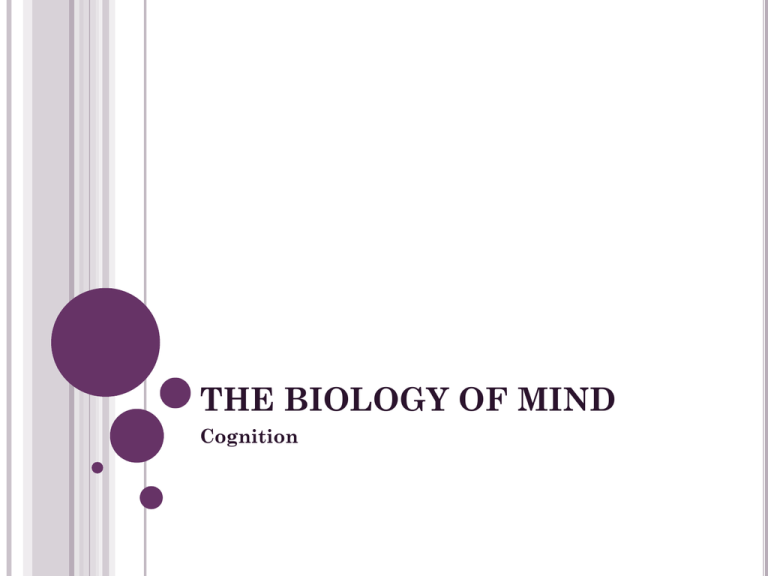File
advertisement

THE BIOLOGY OF MIND Cognition DO NOW: Is the “brain” important in Psychology? How might brain functions shape our personality? BIOLOGY, BEHAVIOR, & MIND Aristotle = Heart To think, feel, and act without a body is like… Plato = Head Biological Perspective:: The interplay of biology, behavior and the mind NEURONS Dendrite fibers [ Listen ] Receive info & give it to cell body = nerve cells Action potential Neurons Axon fibers [ Speak ] Send info to other neurons Myelin Sheath •Protective covering over axons •Fatty tissue that insulates and speeds impulse •Grows up to about age25 – impacts judgment, self-control, and neural efficiency •multiple sclerosis – loss of muscle control NEURAL COMMUNICATION Synapse [ Lock & Key ] •Release Neurotransmitter Binds to receptor site •Reuptake extra neurons by sending neuron Neurotransmitters impact: •Hunger, Thirst, Emotions •Don’t operate in isolation •Acetylcholine (ACh) •Opiate receptors •Endorphins – natural pain killers Agonist : Amplifies normal sensations of pleasure Antagonist: Blocks a neurotransmitters functioning – similar enough to fill receptor site but not enough to stimulate it NERVOUS SYSTEM Nerves = Electrical Cables •Link CNS to sensory receptors The electro-chemical communication network made up of all the nerve cells of the PNS & CNS CNS (Central Nervous System) •Brain & Spinal Cord ➨Sensory neuron carries message to spinal cord ➨Motor neuron: carries instructions to the muscle ➨Interneuron: Brain’s internal network More on CNS in a bit… PNS (Peripheral Nervous System) •Gathers info & Transmits decision from the CNS •Sensory & Motor System ➨Somatic N.S. - voluntary ➨Automatic N.S. – i.e. heartbeat ➨Sympathetic N.S. – alarms ➨Parasympathetic – conserves •Keep body regulated CENTRAL NERVOUS SYSTEM (CNS) 1. BRAIN •Allows us to learn •Strengthens connections between neurons 2. SPINAL CORD •2 way highway between PNS & Brain Motor info Sensory Info How can this be demonstrated? 3. ENDOCRINE system •Hormones •Very slow moving; lasts longer at times •ANS orders adrenal glands to release epinephrine & norepinephrine = increase in heart rate, bp, blood sugar •Pituitary gland •Controlled by hypothalamus •Stimulates physical development •Oxytocin (bonding), Cortisol (stress) THE BRAIN Cerebellum Brainstem Thalamus Reticular Formation •Medulla •Sensory •Sorts •Nonverbal through switchboard learning stimuli& •Receives •Relays memory • Heartbeat info alltosenses other & (but smell) areas •Judges Breathing of time, the brain •Cross-over monitors •Directs emotions, point info to discriminates •Body x Brain medulla &texture and sound cerebellum Cerebral Cortex •thin layer of interconnected neural cells Motor Cortex Parietal Lobe –– Controls Touch & body voluntary position movement Frontal Lobe Sensory Cortex – Speaking, – Processes muscle bodymovement, touch and movement making plans sensations & judgments Occipital Lobe Association areas – Receiving – neuronsinfo involved from visual in higher fieldfunctioning (eyes) ( speaking, Temporal Lobethinking, remembering, – Auditory learning, info (ears) etc.) LIMBIC SYSTEM Amygdala • “Fight or Flight” Hypothalus •Hunger, Thirst, Temp •Sends hormones Hippocampus •Memory CASE STUDY: PHINEAS GAGE BRAIN’S PLASTICITY Ability to modify itself after damage • once neuron is destroyed that’s it! •BUT neural tissue can reorganize itself •What does that mean? Corpus Collosum – band connecting 2 hemispheres •Split Brain •Left: Literal •Rights: Infers, Speech, Sense of self Divided Brain











